England have a plethora of attacking talent heading in the 2021 European Championships. In terms of centre-forward options, it seems as if Gareth Southgate is opting for three traditional strikers in his 23-man squads. In the latest round of international fixtures, the third striker slot went to Ollie Watkins if we assume that Harry Kane and Dominic Calvert-Lewin are ahead of him in the pecking order.
In this scout report, we will be looking at Ollie Watkins’ season with Aston Villa so far, but we will also be compiling an analysis of some of England’s other centre-forward options that could be considered for the squad, namely Patrick Bamford and Callum Wilson. These two are the closest members to making the collective, since Vardy is retired from international duties, and Michail Antonio has selected Jamaica as his nation.
In this tactical analysis, we will cover Watkins’ role in Dean Smith’s system, how well this translates to Southgate’s current setup, and finally concluding why Watkins is the best option of the three.
Player profile
Born in Torquay, Devon, Watkins would begin his footballing career a short move away from the seaside resort town with Exeter City, of whom he would join in 2004 and stay with until 2017, following his move to Brentford, who had spotted him as a 20-year-old impressing in League Two as a wide-forward. It was his move to the side that would propel his career into the limelight and saw him tracked by several clubs after his performances for Brentford. It took him a few years to crack into gear, but once he did, he was fantastic.
Dean Smith purchased the player at Brentford, and it would be the same manager to bring him to the Premier League at Aston Villa. An initial £28 million fee which would rise to £33 million with add-ons made him the 3rd most expensive export out of the Championship (only beaten by Nathan Aké’s transfer to Man City and Moussa Sissoko to Spurs). Despite a history of playing out wide, Watkins was brought into the West Midlands club as an out-and-out #9, and that is what he has been so far for the club.
Standing at 5’11” / 180cm, Watkins more dynamic than most typical #9s who act as a poacher. He carries a triple-threat, as a capable dribbler, good creator, and proficient goal scorer, the 25-year-old adds a lot more to the team than just goals. As the attacking centre-piece in Smith’s 4-2-3-1, Watkins does a lot to create space for star man Jack Grealish in the final third with his diverging runs, but he also exploits the space in behind created by Grealish’s presence in the attacking third to earn himself a handful of quality chances per match.
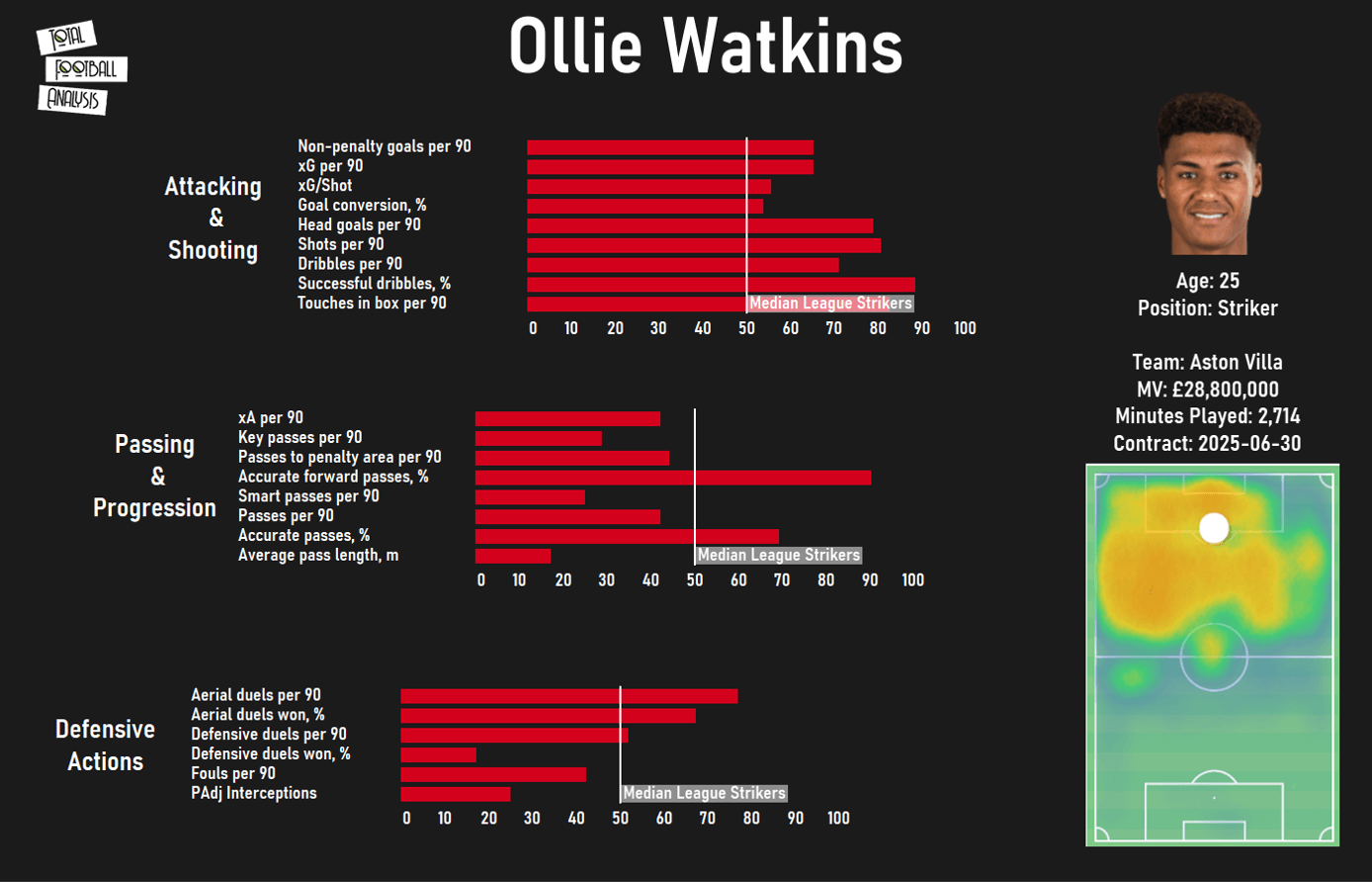
Ollie Watkins player profile, created by the wonderful Sathish Prasad (@SathishPrasadVT on Twitter).
Movement and finishing
As a centre-forward, clever movement in and around the penalty area is key. It is the single distinguishable asset, which is difficult to quantify, but is truly the difference-maker when it comes to how many goals a striker will score at the top level. Ollie Watkins might not be an elite-level finisher, he might never be, but his elusive movement will almost always earn him chances, and by nature, goals in abundance.
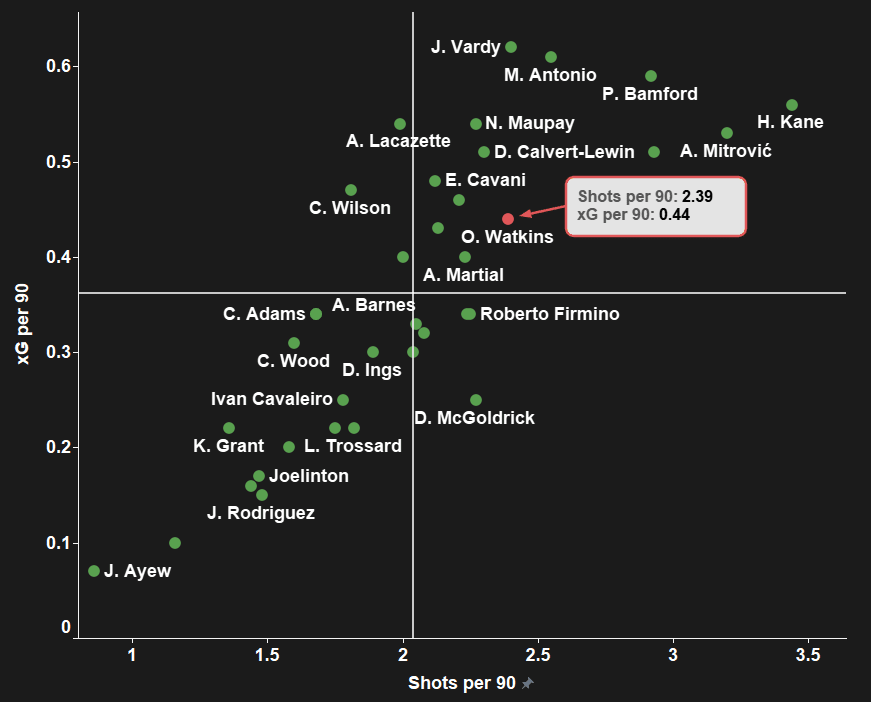
Scatter plot of Premier League strikers’ shots per 90 compared with xG per 90.
One way we can go some way to quantify a centre-forward’s movement is via their shots per 90. The ability to generate a shot on goal is often a result of good movement from the striker, although, of course, strikers in a weaker team will get fewer chances. In terms of xG, it is a decent start for Watkins in the Premier League. According to Understat, Jamie Vardy in his debut EPL campaign was sitting at around 0.31 xG per 90 and look at what he has gone on to achieve. The future is bright for Watkins, who is producing 0.44 xG per 90 this season.
His runs are varied, but his most effective is akin to that of Erling Haaland at Borussia Dortmund. While Grealish roams in-field, Watkins will run from right to left, blindsiding defenders in the process who are focused on Grealish and looking to be met with a through pass into the penalty area. It is his most effective run as it leaves the 25-year-old with time and space inside the box, which suits him best.
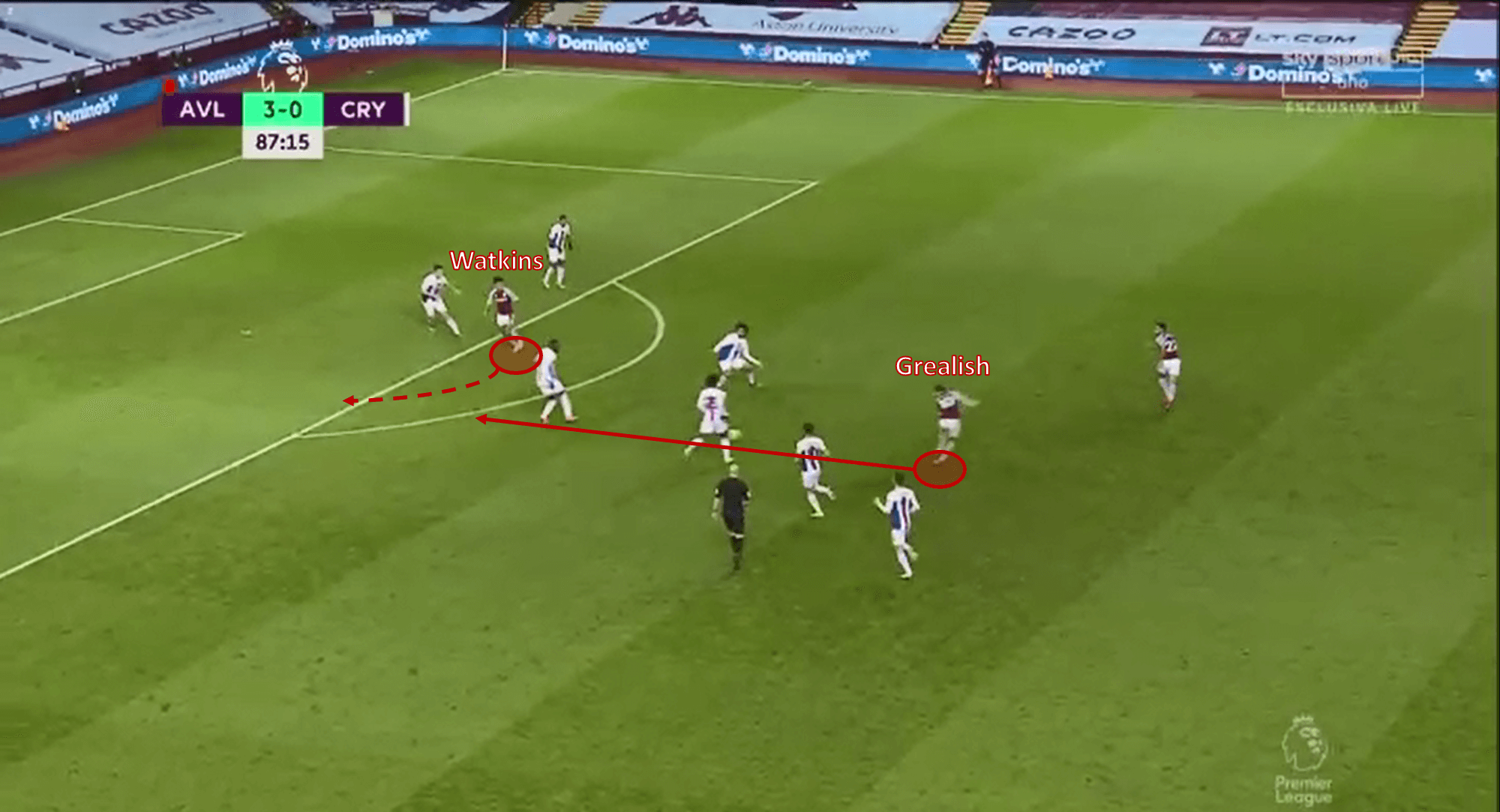
Just like the media, all eyes here are on Grealish. Meanwhile, Watkins makes the run in behind to meet Grealish’s audacious passing effort.
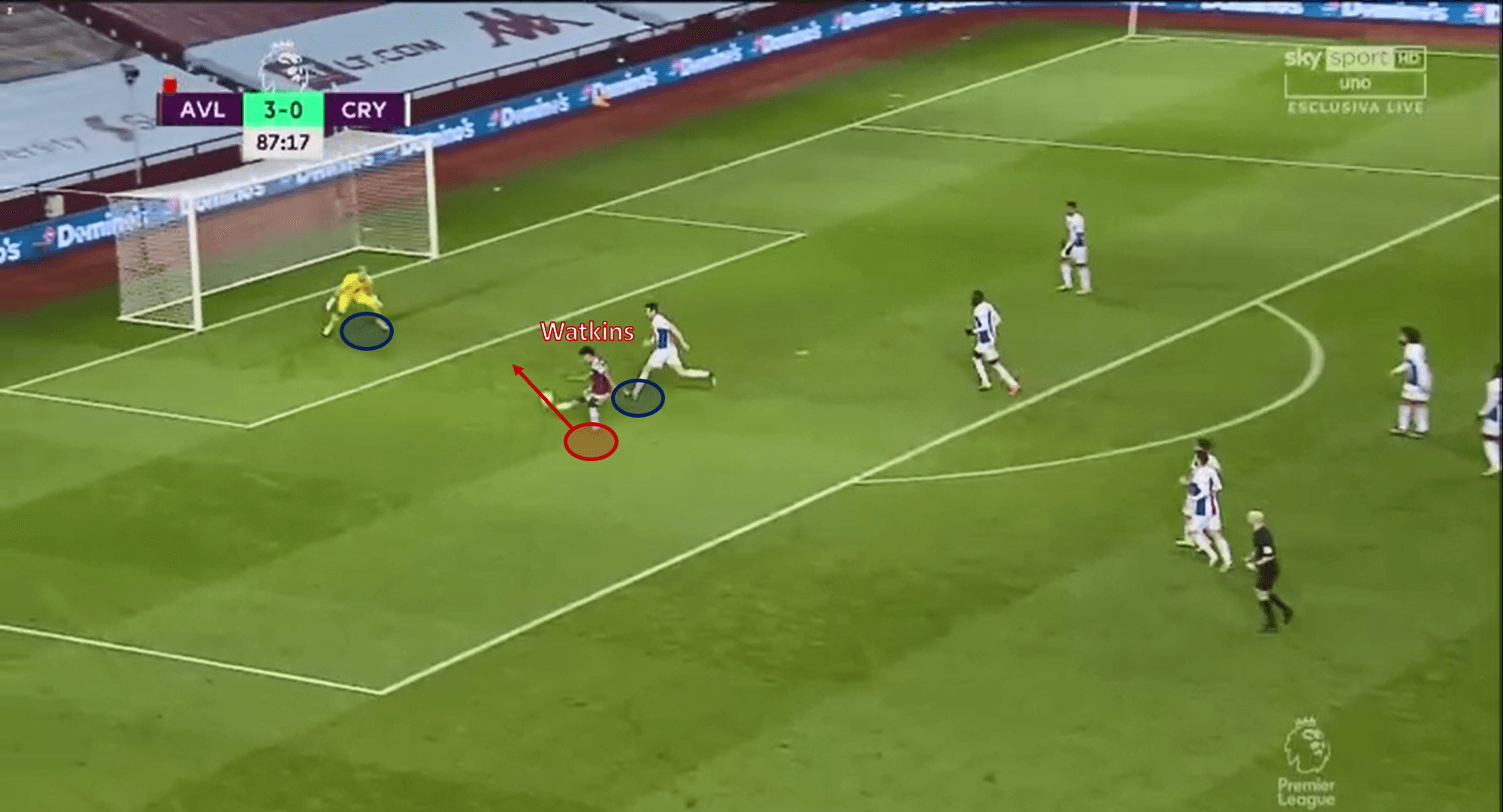
Watkins is unfortunate not to score here. He takes his time to let the ball run through his body, and finesse the ball into the bottom right, only for the ball to travel up the post and into the palms of the keeper.
There are other moments where Watkins will lurk inside the penalty area like a traditional poacher. Part of Smith’s attacking structure is creating triangles in wide zones within the final third, formed by the ball-side winger, full-back, and #10. The widest player should have two options when on the ball, that is the basic concept. When Grealish gets involved, he drives the ball up the pitch, closer towards the box through his ball-carrying alone.
With opposition defenders coming towards his location, this creates space for other attackers, namely Watkins, inside the penalty area. Combining with another forward, Grealish and co can create a chance for Watkins, typically a delivery with height, due to Watkins’s ability to accurately shoot the ball at the goal with his head.
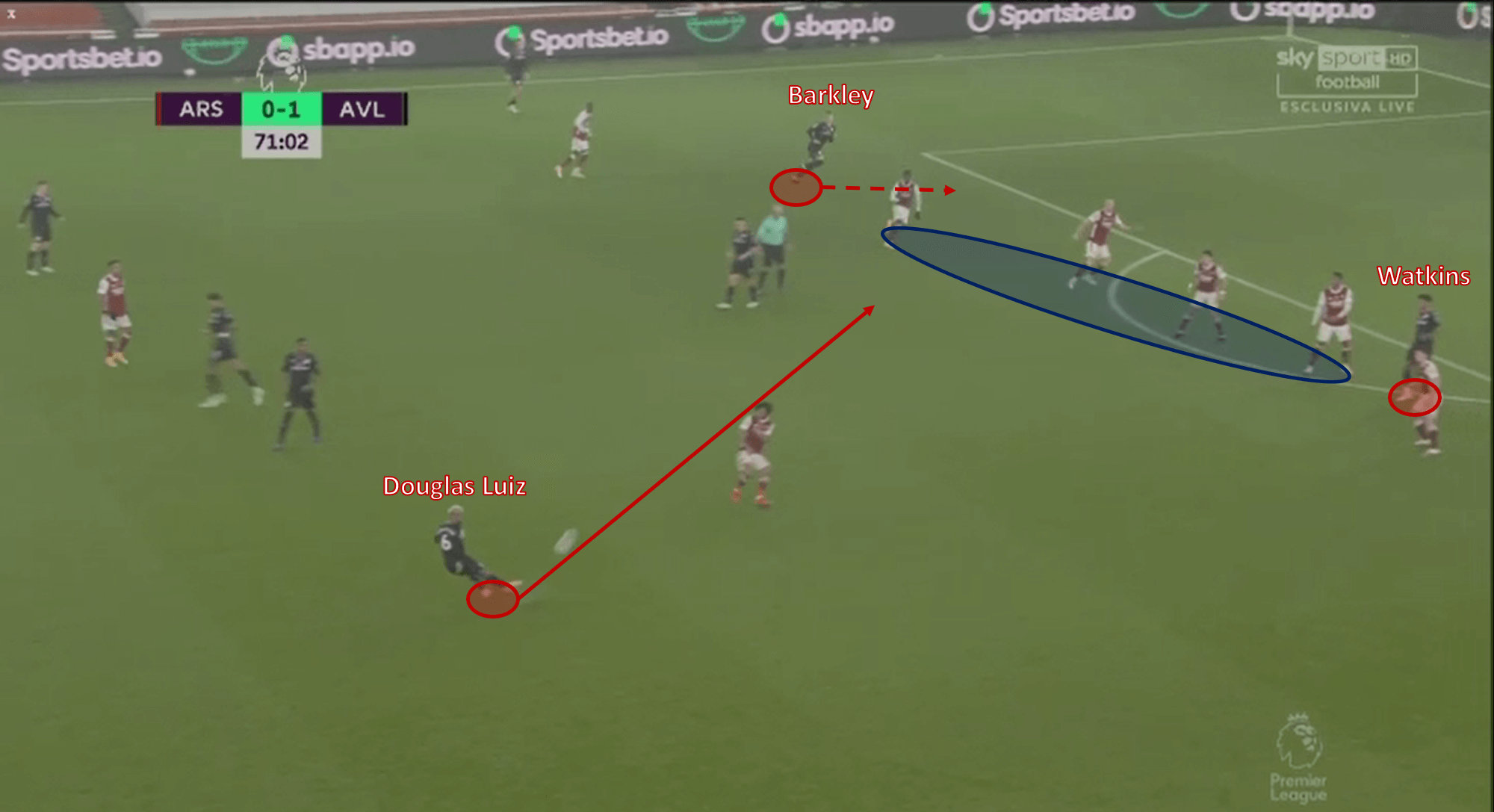
Here, Villa take advantage of a static Arsenal defence by playing the direct ball beyond the defensive line into the path of Ross Barkley.
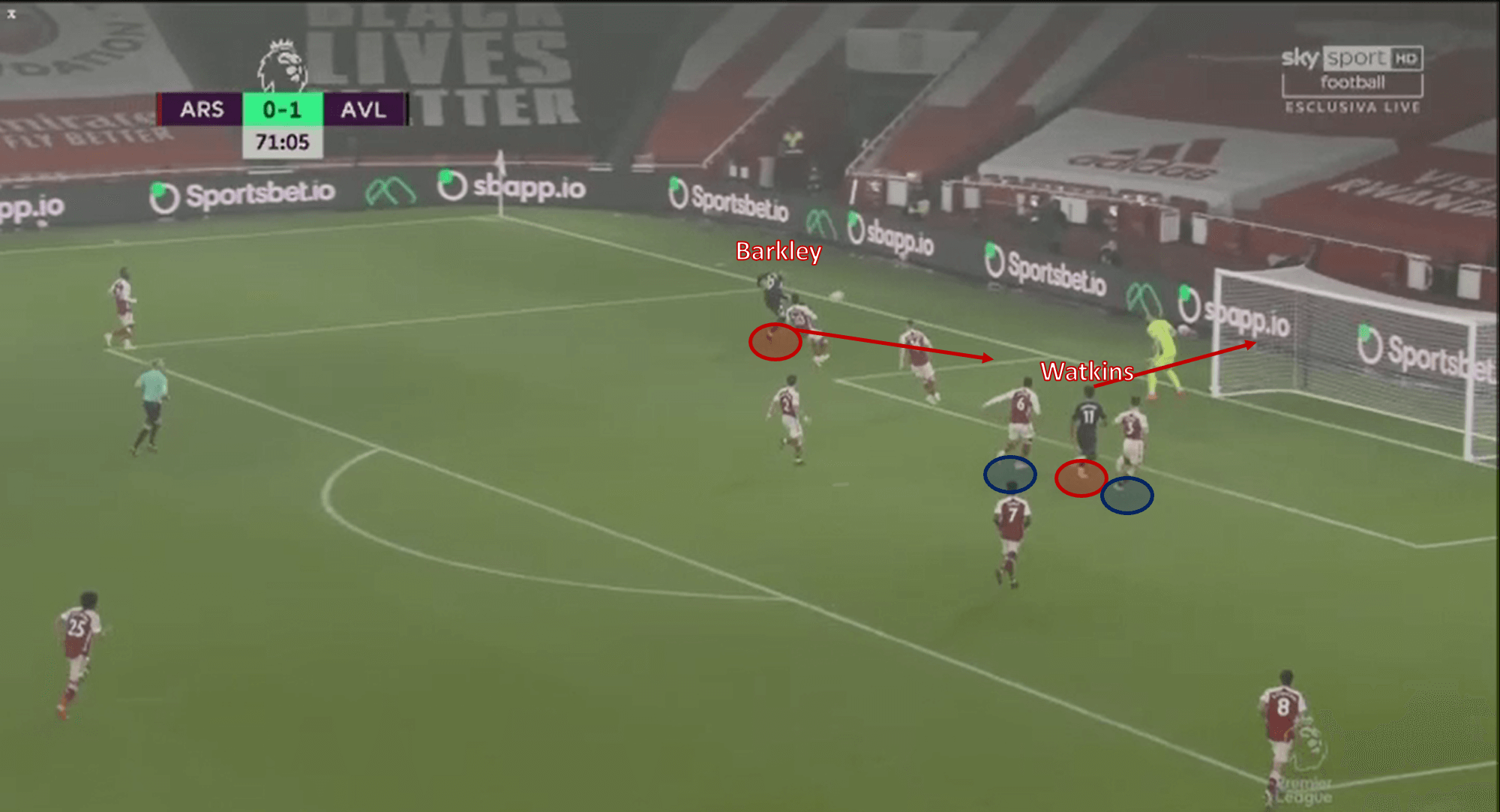
Barkley perfectly executes the first-time volleyed cross towards Watkins’s head, who cushions the header into the roof of the net.
As much as Watkins does have great movement in the final third, his performance in front of the goal could be improved upon at times. He is not a bad finisher, far from it, but on occasions where he is one-on-one with the goalkeeper, and they do as much as they can to make themselves seem bigger than the net, he can lose his head. Sometimes he seems indecisive in these moments, and by the time he does shoot, he has already lost.
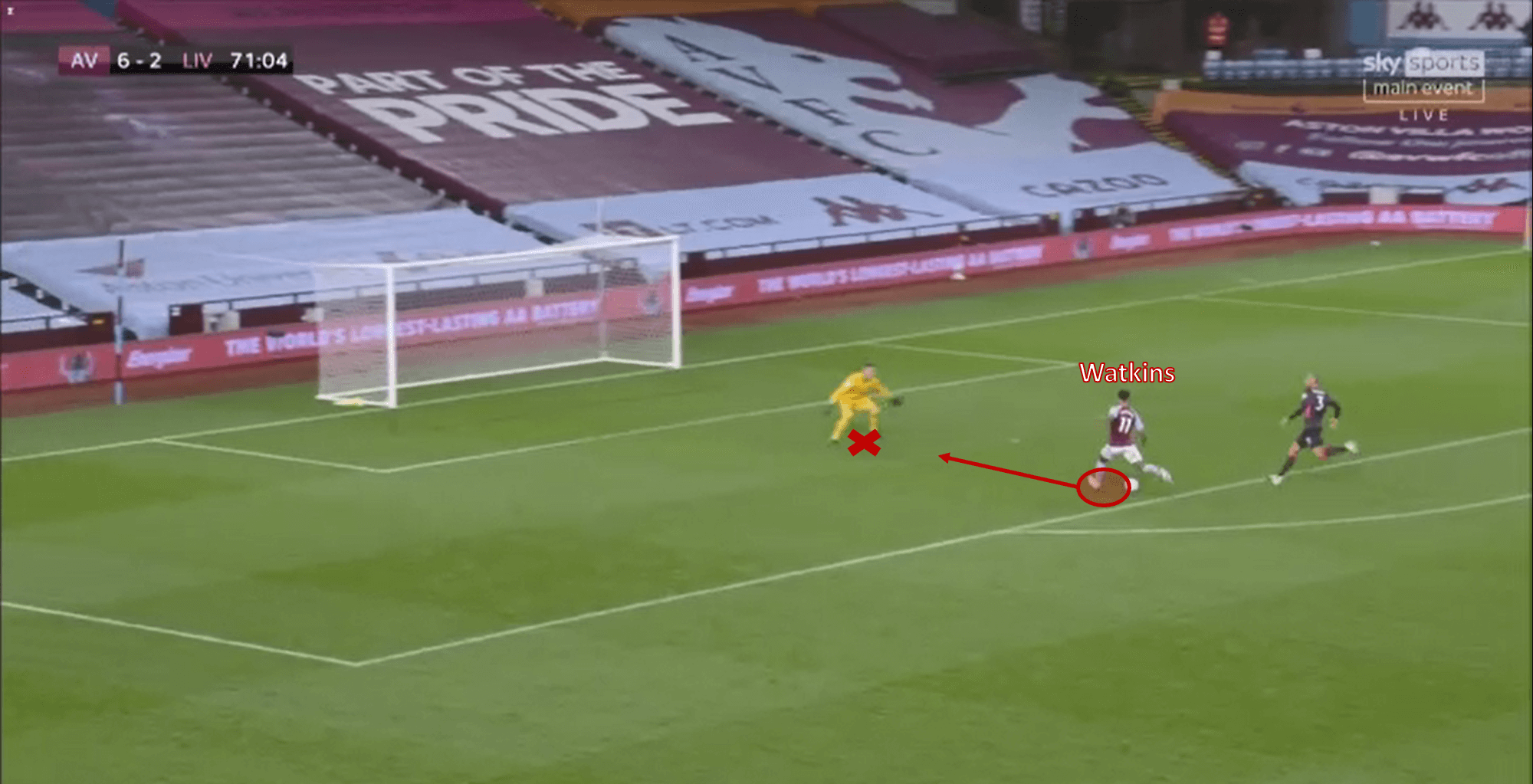
Take one of his chances against Liverpool. One-on-one against Adrian, who he had already put three past at this point mind you, he does not curl the ball around the Spaniard, instead, shooting right into his feet.
Chance creation & ball-carrying
Since his breakthrough at Brentford, and his transition to a centre-forward from more of a wide operator, Watkins’s creative performance has been gradually declining over the years. This is due to a heavier emphasis on grabbing goals. However, we understand that Watkins certainly has chance creation in his locker, but due to his current role, statistically, it might look like a weak point.
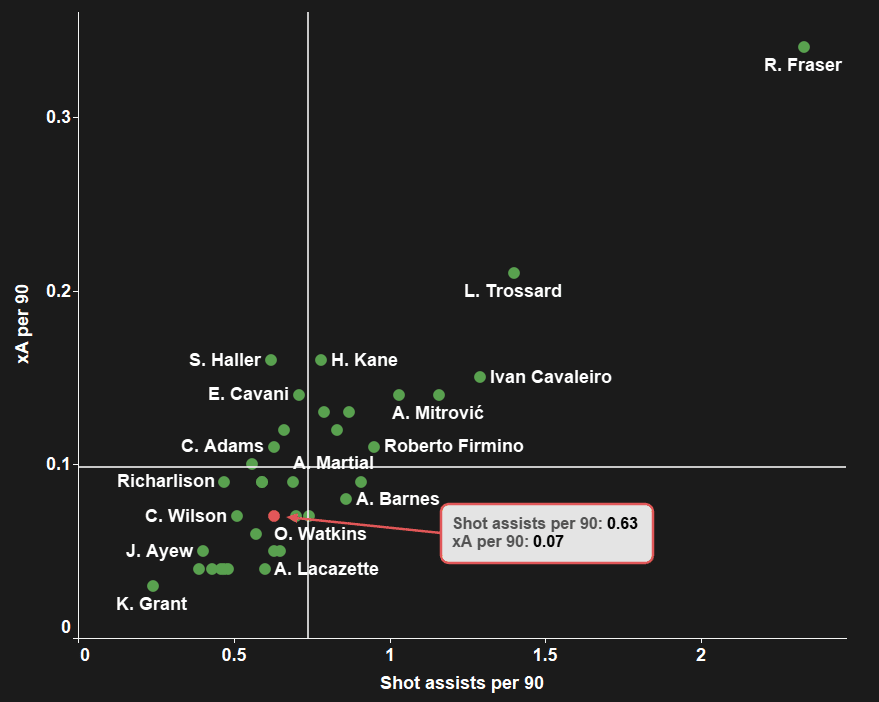
Scatter plot of Premier League strikers shot assists per 90 combined with xA per 90.
When looking at the scatter plot, it does not make for pretty viewing for Watkins. Although, traditional wingers, such as Ryan Fraser and Leandro Trossard do skew this data somewhat, and in actuality, both of these figures are more towards the average side for a #9 than the graph is leading us to believe. Nonetheless, his current rate of 1.1 key passes per 90 is down on last season’s 1.5 in the Championship, and down from 2.2 a few years before then.
Watkins likes to roam in wide areas with the ball at his feet and burst his way towards the byline. He possesses impressive pace, he is not the fastest player in the league, but he is certainly up there for speed. His dribbling technique is adequate, there is no real flair involved. He usually slows down the ball and then he decides when to speed up and go past his opposing man.
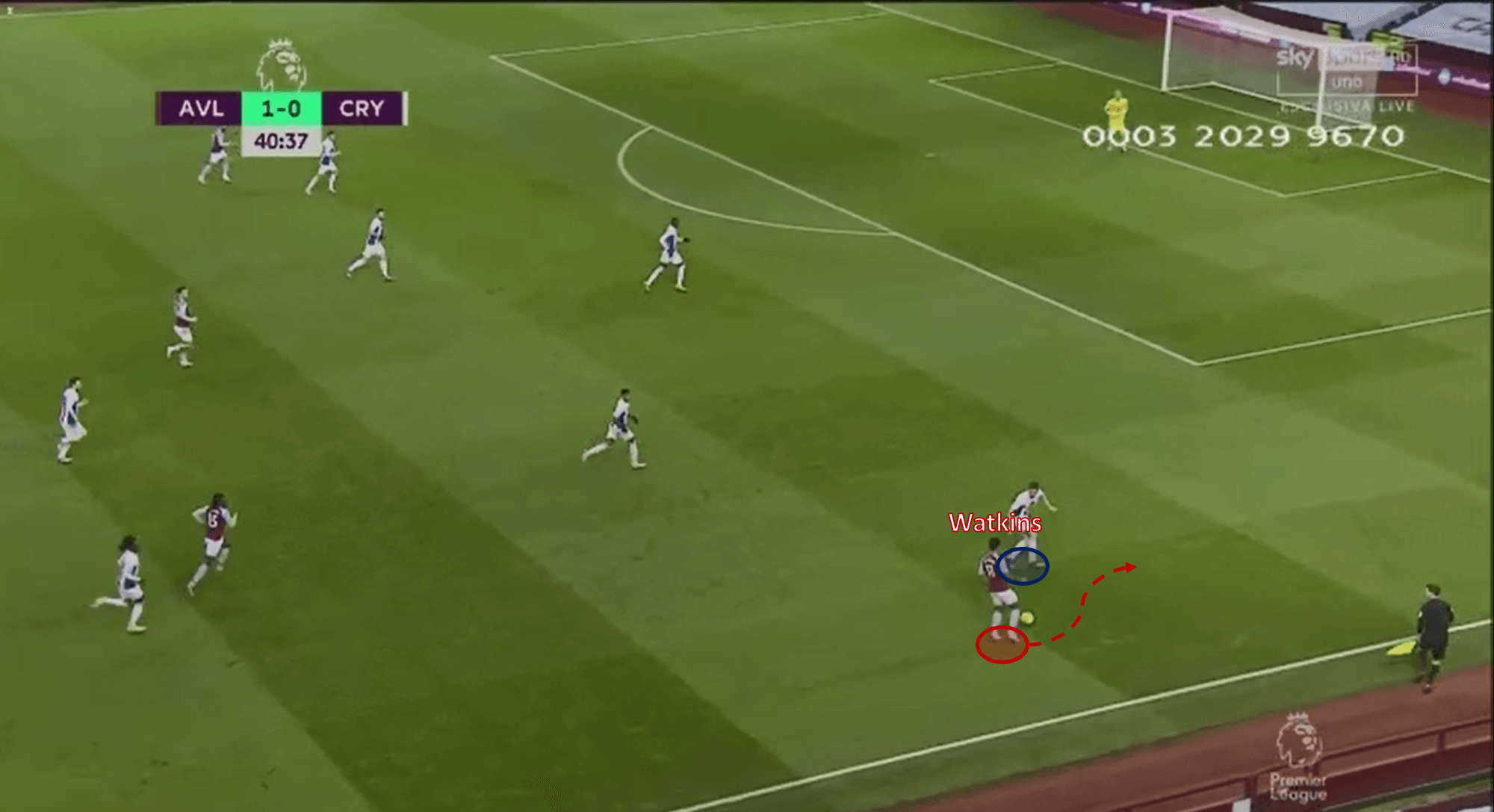
As we can see above, Watkins slows down the pace of his dribble, before hunching over and pushing the ball in front of him and down towards the byline.
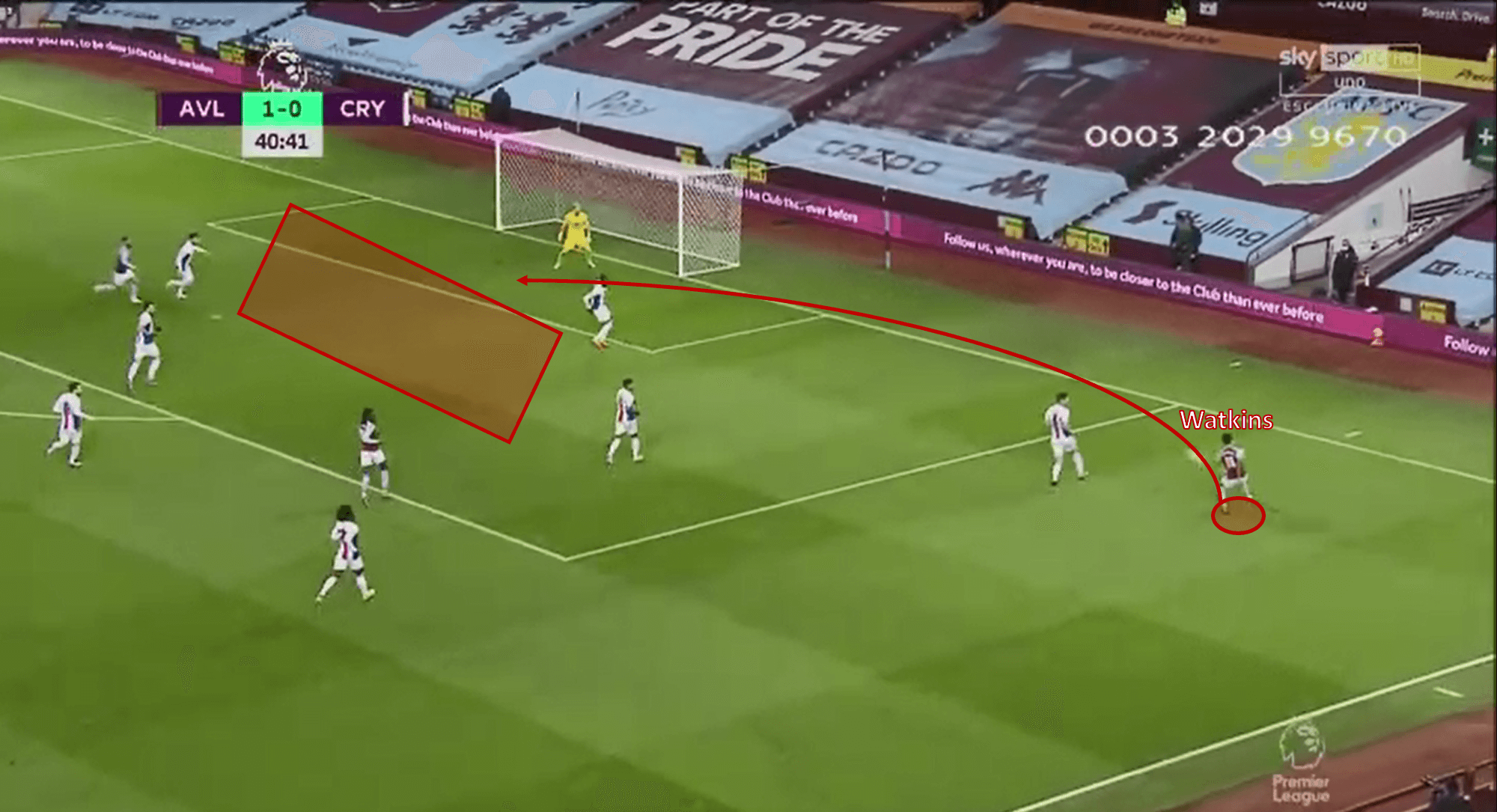
Watkins send the ball into a dangerous area, where another attacker ought to be positioned, primed, and ready to attack it.
Watkins likes to run the channels. We see this regularly from him, constantly asking questions of an opposition’s defensive structure, as well dragging defender out to wide areas too. Although his movement creates a lot of chances for himself, it also creates just as many for others, again, in a way that cannot really be quantified.
When it comes to ball-carrying, he is one of the more adept centre-forwards in the division already. As we mentioned, his technique or natural flair is not of an elite level, but it is effective and crucial to the way that Dean Smith likes his side to play. It makes Watkins one of the most well-rounded #9s in the league.
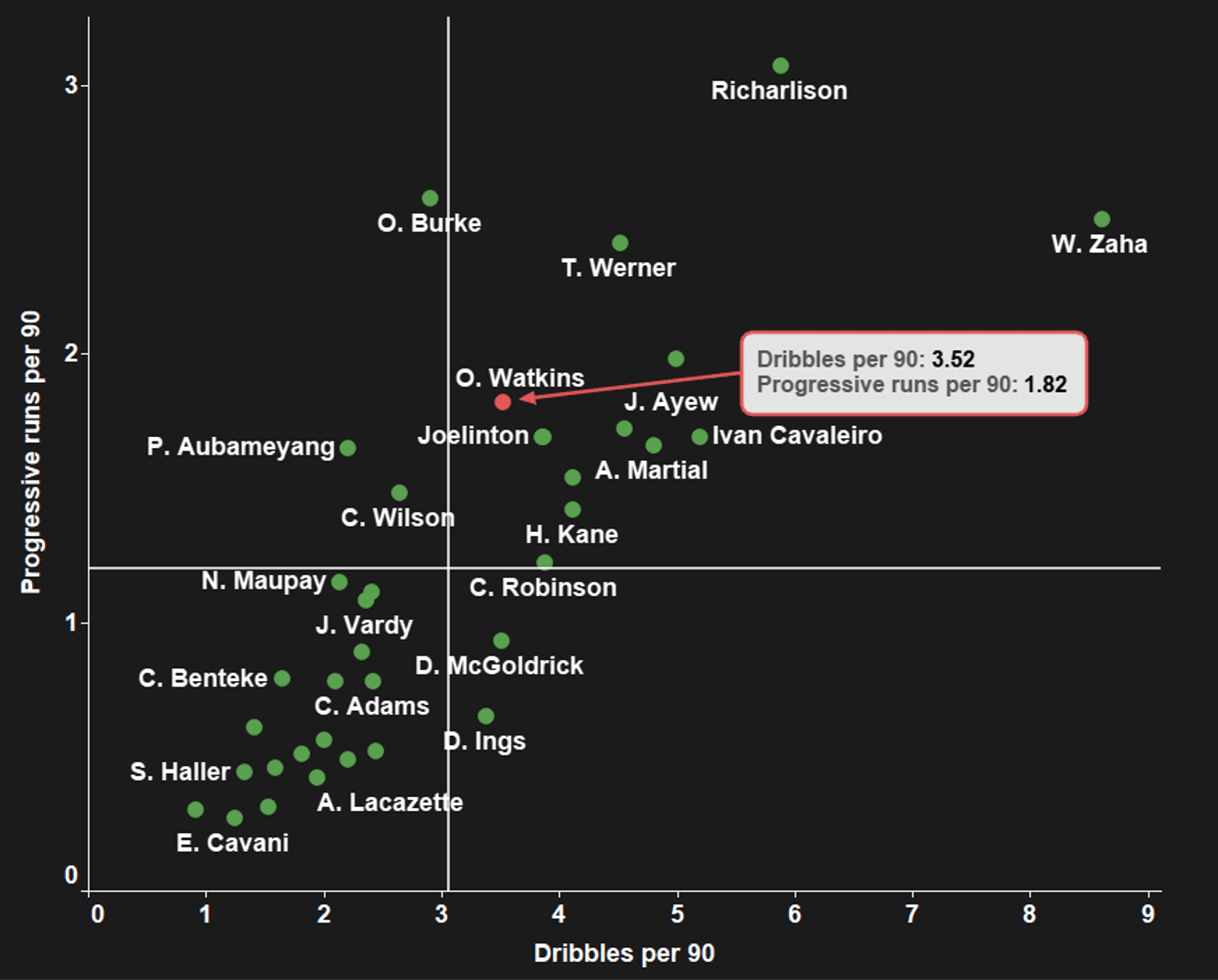
Scatter plot of Premier League strikers’ dribbles per 90 combined with progressive runs per 90.
A statistical comparison with England’s other candidates
The third-choice striker for this round of England fixtures turned out to be Watkins, but the question many are raising is: did he deserve it over Bamford or even Wilson? They have all had successful seasons, but the other two perhaps surprised the masses more so. Many Leeds fans were calling for Rodrigo to be Elland Road’s starting striker, while Wilson signed for a very subpar Newcastle side. It is also worth noting Tammy Abraham and Danny Ings in this conversation, but in this piece, we will focus on the three most-realistic candidates.
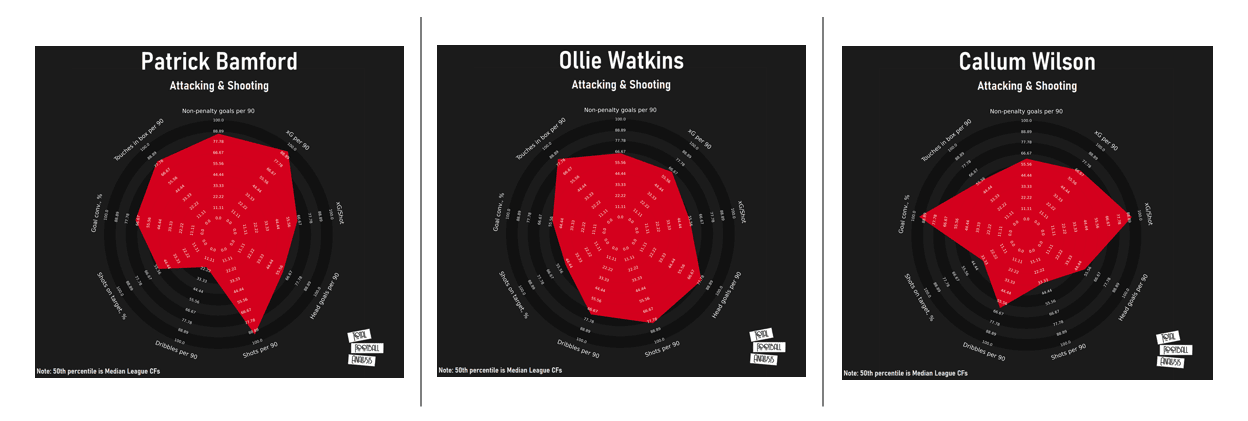
Well, in terms of goal contributions per 90, Watkins lags behind both of his competitors. While Watkins sits on 0.46 goals + assists per 90, Bamford and Wilson are currently going at a rate of 0.74 and 0.75, respectively. This is some going for both of the Northern-based strikers and it beats out Watkins rate by some distance. Although when we alter this to goals – penalty kicks per 90, Watkins strides ahead of Wilson at a rate of 0.32 compared to 0.30. Four of the Newcastle man’s goals have been from the penalty spot, so that should be considered.
In one of the only ways these three players beat out Kane and Calvert-Lewin, they all engage in a fair bit of pressing for each of their respective sides. Not entirely surprisingly, Bamford applies pressure the highest number of times per 90 at 16.6, compared with Watkins’ 15.6 and Wilson’s 13.9. Though, Watkins has the highest success rate with 31.1%, meaning he completes a minimal amount less than Bamford per 90 in actuality.
One statistic which Watkins does excel in out of the three men is in carries and progressive carries. It is a unique part of his game, and vital to the way that Villa like to play in the final third. He completes 22.5 carries per 90, with 3.75 of those being progressive efforts, which far exceeds both Bamford and Wilson with 12.8 and 19.3, respectively. This goes with the notion that Watkins is the most well-rounded forward of the trio.
Of all three, Watkins is the only player to underperform his xG by a significant margin, scoring 10 goals when xG expected him to have 12 strikes to his name. Watkins also maintains the lowest xA figure of the three as well. Watkins is producing a below-average number of 0.11 xA per 90 compared to 0.22 for Bamford and 0.25 for Wilson, which is probably the most surprising statistic of all. Although given Watkins operates a bit deeper than the other two, it makes sense that his direct goal contributions are lower than the other two.

So, in many ways statistically, Watkins does not match with Bamford and Wilson. However, with context, considering Wilson most likely will not take penalties for England, his scoring rate is more comparable with Watkins than initially feared, but Bamford seems in a league of his own in this regard. In terms of playing style, Southgate’s 4-3-3 is most akin to Smith’s 4-2-3-1 out of the three teams, as its pressing intensity is not quite as high as Bielsa’s Leeds.
Forecast for the future
Honestly, it is a tough pick between Bamford and Watkins. They are two very distinct players but offer similar values in terms of goals, assists, and towards the defensive side of their systems requirements. While Bamford provides slightly more intense pressing, he is also a poacher, who does not like to roam outside of the penalty area, as that is where he will get the most goals.
Watkins though, provides good pressing, good dribbling, good finishing, and good chance creation. My point being, he does not excel at anything especially, but he is at a decent level for each attribute. A level that can only improve with more game time. Now, he has scored his first goal for England and undoubtedly impressed Southgate. Only time will tell whether he can keep his place come the European Championships in June.





Comments